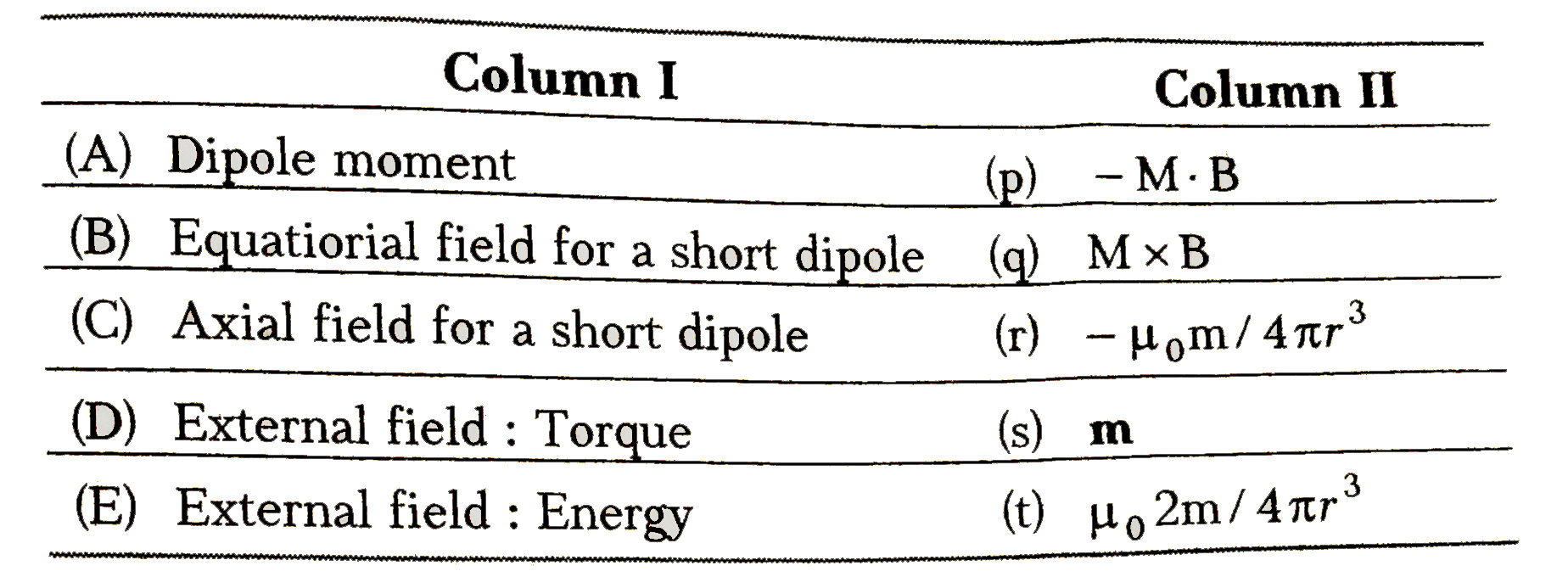The ratio of magnetic dipole moment to angular momentum of electron is
em
2em
e2m
e4m
The correct Answer is:C
To find the ratio of the magnetic dipole moment (μ) to the angular momentum (L) of an electron, we can follow these steps:
Step 1: Define the magnetic dipole moment
The magnetic dipole moment (μ) of a current loop is given by the formula:
μ=I⋅A
where I is the current and A is the area of the loop.
Step 2: Calculate the current (I)
The current (I) due to the electron moving in a circular orbit can be expressed as:
I=eT
where e is the charge of the electron and T is the time period of one complete revolution. The time period T can be calculated as:
T=2πrv
where r is the radius of the orbit and v is the velocity of the electron. Thus, we can substitute T into the equation for current:
I=e2πrv=ev2πr
Step 3: Calculate the area (A)
The area (A) of the circular path of the electron is given by:
A=πr2
Step 4: Substitute I and A into the formula for μ
Now substituting I and A into the formula for magnetic dipole moment:
μ=I⋅A=(ev2πr)⋅(πr2)=evr2
Step 5: Define angular momentum (L)
The angular momentum (L) of the electron is given by:
L=mvr
where m is the mass of the electron.
Step 6: Calculate the ratio of μ to L
Now we can find the ratio of the magnetic dipole moment to angular momentum:
μL=evr2mvr
Simplifying this expression:
μL=evr2mvr=e2m
Conclusion
Thus, the ratio of the magnetic dipole moment to the angular momentum of the electron is:
μL=e2m
Final Answer
The ratio of magnetic dipole moment to angular momentum of the electron is e2m.
---
The magnetic dipole moment (μ) of a current loop is given by the formula:
μ=I⋅A
where I is the current and A is the area of the loop.
The current (I) due to the electron moving in a circular orbit can be expressed as:
I=eT
where e is the charge of the electron and T is the time period of one complete revolution. The time period T can be calculated as:
T=2πrv
where r is the radius of the orbit and v is the velocity of the electron. Thus, we can substitute T into the equation for current:
I=e2πrv=ev2πr
The area (A) of the circular path of the electron is given by:
A=πr2
Now substituting I and A into the formula for magnetic dipole moment:
μ=I⋅A=(ev2πr)⋅(πr2)=evr2
The angular momentum (L) of the electron is given by:
L=mvr
where m is the mass of the electron.
Now we can find the ratio of the magnetic dipole moment to angular momentum:
μL=evr2mvr
Simplifying this expression:
μL=evr2mvr=e2m
Thus, the ratio of the magnetic dipole moment to the angular momentum of the electron is:
μL=e2m
The ratio of magnetic dipole moment to angular momentum of the electron is e2m.
Similar Questions
The angular momentum of d electron is
View SolutionThe angular momentum of p electron is
View SolutionThe ratio of magnetic dipole moment and angular momentum of charged body of charge q and mass m is
View SolutionAn electron revolves anti-clockwise around a proton in a hydrogen atom. The speed of electron is v and radius of its circular orbit is r. find
(i) The magnetic field produced at the centre
(ii) Magnetic dipole moment of circulating electron
(iii) The ratio of magnetic moment of angular momentum of electron
Strategy: A charge in motion constitutes current. Therefore, an electron moving on circle is equivalent to a current carrying loop
View SolutionWith reference to magnetic dipole, match the tems of Column I with the tems of Column Ii and Choose the correct option from the codes given below.

View SolutionAn electron moves with a constant speed v along a circle of radius r.(a) find the equivalent current through a point on its path.(b) Find the magnetic moment of the circulating electron.(c ) Find the ratio of the magnetic moment to the angular momentum of the electron.
View SolutionThe orbital angular momentum of 3p electron is :
View Solutionthe orbital angular momentum of 4f electron is
View SolutionThe rartio (inS1units) of magnetic dipole moment to that of the angular momentum of an electron of mass mkg and charge e coulomb in Bohr's orbit of hydrogen atom is
View SolutionThe ratio of magnetic dipole moment and angular momentum of charged body of charge q and mass m is
View Solution